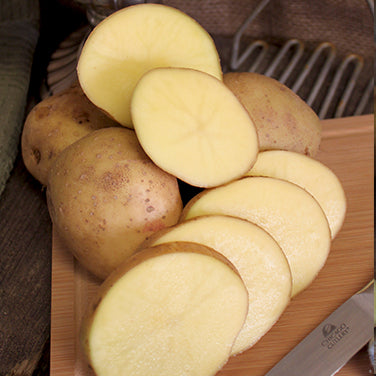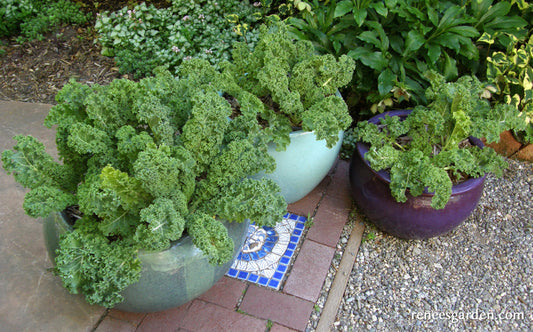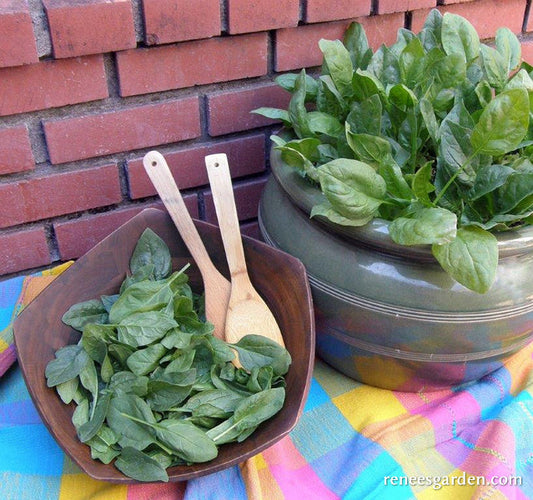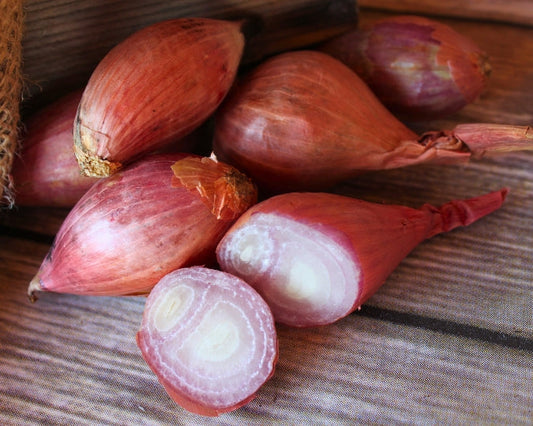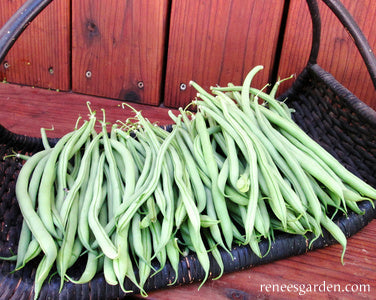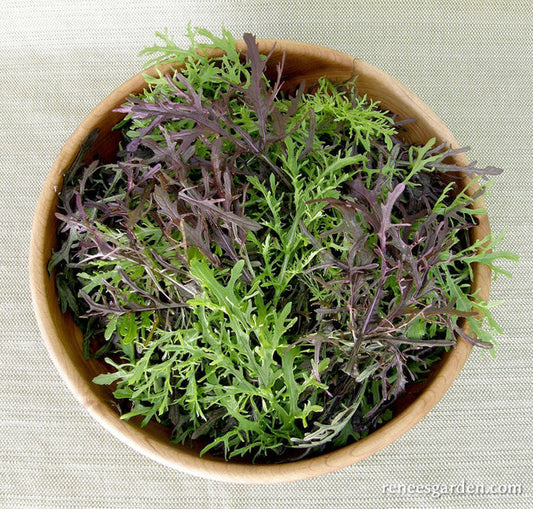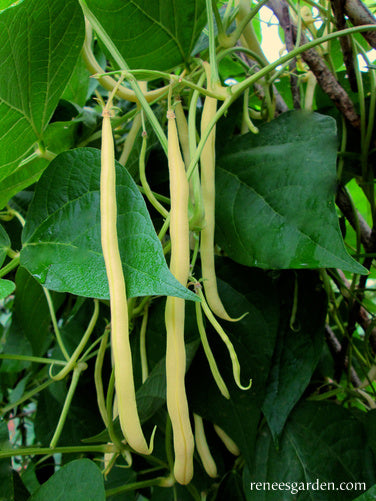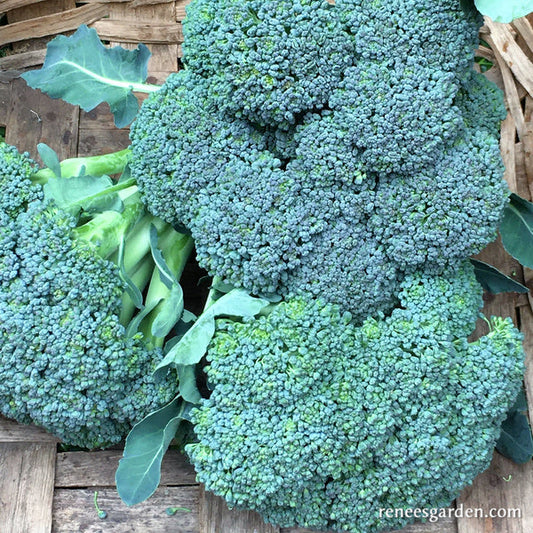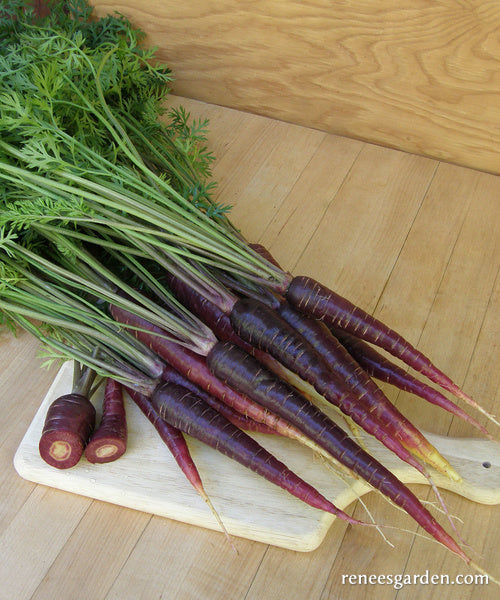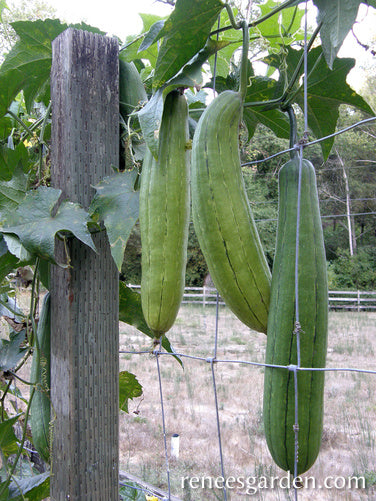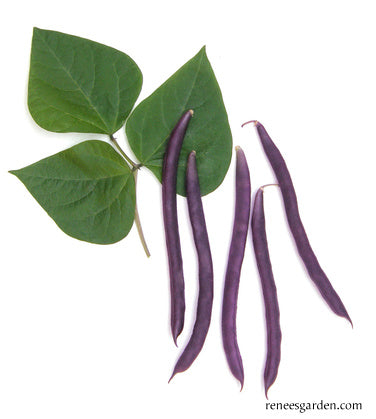Vegetables
Set The Table From Your Garden
-
Heirloom Pole Beans Rattlesnake & Purple Pole
START SEEDS OUTDOORS
In spring once weather is warm and settled and night temperatures stay securely above 55°F (13°C), plant seeds in well-worked, fertile soil in full sun. Erect strong stakes, tripod poles, or trellis at planting time for support. Plant seeds 1 inch deep and 4 inches apart along a trellis, or if planting around tripods or stakes, plant 4 to 6 seeds 4 inches from each pole, thinning seedlings to 3 best plants.
GROWING NOTES
Beans are easy to grow, but wait until spring weather is warm both night and day to plant them, because cold conditions prevent good germination. If first sowing comes up unevenly, replant right away; new seedlings will catch up quickly. Birds are often attracted to young bean seedlings, so watch carefully and protect with netting or floating row covers if necessary. Avoid cultivating plants or picking pods when plants are wet.
HARVEST AND USE
Both these heirloom pole varieties are heavy bearers, so harvest pods often. The more you pick, the more plants will produce. Harvest for snap beans when pods are well filled out, but bean seeds have not swelled in the pods. Cook just until tender to enjoy best flavor and texture. For dried beans, let some of the Rattlesnake bean pods fully mature and dry on the plants if you want to shell out the pretty mottled beans inside to enjoy in dried bean recipes and chili.
Regular price $3.69Sale price $3.69Unit price / per -
Tall Snap Peas Magnolia Blossom
START SEEDS OUTDOORS
In early to mid-spring, plant peas in full sun in well-worked, fertile soil. Sow seeds 1 inch deep and 3 to 4 inches apart in wide rows or bands 3 inches across, spacing the rows 2 feet apart. Provide supports for these climbing 5-8 foot vines at planting time. Protect from marauding birds with netting or floating row covers if necessary. Cold and wet early spring weather may affect germination, so if first sowing doesn’t germinate evenly, replant right away as new seedlings catch up quickly. Sow again for a fall crop about 2 1/2 months before first expected fall frost.
GROWING NOTES
These are hypertendril peas, meaning that the vines will produce long twirling tendrils in place of some leaves. This trait helps increase air flow so there is less disease potential. Use netting or wire trellis to support these heavy bearing tall vines for easy picking. Keep pea vines well weeded and watered and mulch to conserve moisture. Water at the base of the plants to avoid mildew.
HARVEST AND USE
Harvest only when peas are mature and round in the thick walled, juicy pods for the best developed flavor. Savor their sweet crunch fresh from the garden (kids especially love them!) as a snack or slice into salads. Pick pods regularly and you’ll have longer production of new ones. To cook quickly, pull strings from pods and sauté in a little oil just until pods turn a deeper green color.
Regular price $4.39Sale price $4.39Unit price / per -
Long Keeping Onions Rainbow Trio
FOR BEST RESULTS
Sow seeds in early spring as soon as soil can be worked; in mild winter areas, seeds can also be sown in fall to overwinter for a head start in spring growth. To Start Early Indoors: Sow 1 in. apart in a container of seed starting mix and cover 1/4 in. deep. Provide a strong light source until seedlings are 2 to 3 in. tall. Transplant 4 in. apart, burying crowns 1 in. deep. To Start Outdoors: Sow seeds in well-worked, fertile soil in full sun. Space 1 in. apart in rows 8 in. apart. Cover 1/4 in. deep, firm soil well over seeds, and keep evenly moist. Thin seedlings gradually to a final 4 in. spacing, using the tasty thinnings.
GROWING NOTES
Before planting, thoroughly work compost or well-aged manure and bonemeal into the soil. Keep onions well weeded and mulch plants once soil warms up to conserve moisture. Feed onions lightly with an all-purpose fertilizer several times during the growing season.
HARVEST AND USE
Harvest midsummer when bulbs are sized up and about half the onion tops are bent over. Stop watering and bend the rest of the tops down. After another 7 to 10 days or when tops are dry, pull the bulbs. If possible, let the onions dry in the sun for 5 to 7 days. Store bulbs in a cool, airy place.
Regular price $3.99Sale price $3.99Unit price / per -
Heirloom Slicing Cucumber Patty’s Marketmore
START SEEDS OUTDOORS
Plant heat loving cucumbers only when weather is warm and settled and night temperatures stay above 50°F (10°C). Amend soil well with aged manure or compost. Sow groups of 2 to 3 seeds 1 1/2 feet apart and 1 inch deep with 3 feet between rows. Thin to 1 strong seedling per group.
GROWING NOTES
Protect seedlings from marauding birds with plastic berry baskets, removing before plants get crowded. Shallow rooted cucumbers need ample and consistent moisture. Avoid overly wet or dry periods for good quality fruit. Growing cucumber vines up vertical supports gives you long, straight fruits and saves garden space.
HARVEST AND USE
Cut rather than pull fruits from vines before seeds are large inside. Harvest every few days for longest fruit production. These crunchy, sweet cucumbers are perfect to slice and enjoy for refreshing snacks, in salads and sandwiches. Eat within a day or two of picking for best taste and quality.
Regular price $4.89Sale price $4.89Unit price / per -
Heirloom Turnip Purple Top Milan
START SEEDS OUTDOORS
In early spring, as soon as ground can be worked, sow in well worked, fertile soil in full sun. Space seeds 1-2 inches apart in wide rows 6 inches apart. Cover 1/2 inch deep. Keep soil evenly moist and well weeded. Carefully thin seedlings early to stand 4-6 inches apart, giving them room to size up. Provide consistent moisture.
GROWING NOTES
Make a second spring sowing 10 days later, before summer heat. Protect with floating row covers if marauding birds or flea beetles that chew holes in the leaves are a problem. Sow again mid to late summer for fall harvest.
HARVEST AND USE
Begin harvesting when the turnips reach 2 to 3 inches in diameter. If weather turns unexpectedly hot, pull and store the roots in the refrigerator.
Note: Turnips are always spicier when the weather turns hot. Slice and sauté or steam; use in soups and stews, or (and this is our favorite) just cut them in quarters or large chunks, toss with olive oil, then roast in the oven until tender to bring out their natural sugars. Enjoy the tasty, nutritious green tops steamed or quickly braised.
Regular price $4.89Sale price $4.89Unit price / per -
Container Snap Peas Little Crunch
START SEEDS OUTDOORS
In early to mid-spring, plant peas in full sun in well-worked, fertile soil. Sow 1 in. deep and 3 in. apart. Protect from marauding birds with netting or floating row covers if necessary. Wet, cold early spring weather may affect germination, so if first sowing doesn’t germinate evenly, replant right away: new seedlings catch up quickly. Sow again for a fall crop, several months before fall frosts.
FOR CONTAINERS
Plant in pots at least 15-18 in. in diameter and 12 in. deep. Sow 1 in. apart, 1 in. deep. When seedlings are 2-3 in., thin to 3 in. apart, so each little vine has growing room. Provide 2-3 ft. tall supports or a short trellis at planting time. Mulch to conserve moisture. Feed with all-purpose fertilizer every 2-3 weeks. If it gets hot, check and water containers daily; otherwise, water when the top inch of soil is dry. Water at base of the plants to avoid mildew.
HARVEST AND USE
Harvest only when peas are mature and rounded in the thick-walled, juicy pods for the best developed flavor. Savor their sweet crunch fresh (kids especially love them!) as a snack or slice into salads. To cook quickly, pull strings from pods and sauté in a little oil just until pods turn a deeper green color.
Regular price $4.69Sale price $4.69Unit price / per -
Heirloom Container Tomatoes Tasmanian Chocolate
STARTING SEEDLINGS
In early spring, start indoors about 6 to 8 weeks before outdoor night temperatures are reliably in the 50-55°F (10-13°C). Sow seeds 1/4 inch deep and 1 inch apart in a container of seed starting mix. Keep moist but not soggy, and very warm, 80°F (27°C). Provide a strong light source until seedlings are ready to plant outside. When seedlings are 2 inches tall, transplant into individual 4 inch pots. Maintain at 70°F (21°C). Feed with half-strength fertilizer every 2 weeks until ready to plant. When nights reach 55°F (13°C), gradually acclimate to outdoor conditions. Plant these vigorous, early bearing vines 3 feet apart into rich soil in full sun.
TO GROW IN CONTAINERS
Use pots at least 15-18 inches in diameter and 18 inches tall. Use fresh potting mix to prevent soil borne disease. Transplant one seedling per pot. Water regularly: in hot weather, pots may need daily watering. Fertilize every other week with a low nitrogen fertilizer for strong plants and good yields.
GROWING NOTES
Tomatoes need at least 6 hours of full sun every day. Provide strong stakes or wire cages at planting time as plants get heavy with fruit. Mulch plants well to maintain even moisture. Pick fully ripe. Don’t store tomatoes in the fridge.
Regular price $4.89Sale price $4.89Unit price / per -
Heritage Chile NuMex Joe E Parker
START SEEDS INDOORS
In early spring, start seeds indoors 6-8 weeks before night temps reach 55°F (13°C) range. Sow seeds 1/4 inch deep and 1 inch apart in seed starting mix. Keep moist but not soggy and very warm, 80-85°F (27-29°C). Provide a strong light source until ready to plant outside. When seedlings are 2 inches tall, transplant into individual 4 inch pots. Maintain at 70-75°F (21-24°C). Feed with half-strength fertilizer every 2 weeks until weather is warm enough to gradually acclimate seedlings to outdoor conditions. Transplant 2-2½ feet apart into rich soil in full sun.
GROWING NOTES
Do not transplant chiles outdoors until night temperatures stay securely above 55° (13°C). Prepare soil well with aged manure or compost. Plant only robust seedlings with well developed roots. Mulch well to maintain even soil moisture. Stake or cage chile plants to support their heavy fruit sets. Keep weeded, watered and feed monthly throughout the growing season.
HARVEST AND USE
Harvest when chiles have a high gloss by cutting, not pulling, them from the plant. Color develops as chiles mature; pick green or allow to color up to rich red. Enjoy in all kinds of delicious salsas, fajitas, chile rellenos, rich sauces, rubs, soups or stews. Use fresh, or roast and remove skins. Freeze roasted chilies for future use.
Regular price $3.69Sale price $3.69Unit price / per -
Classic Rutabagas Improved Helenor
START SEEDS DIRECTLY OUTDOORS
Mild Winter Areas: In midsummer, sow seeds in well-drained garden soil in full sun. Sow 2 inches apart and 1/2 inch deep in rows 12 inches apart. When several inches tall, thin seedlings to stand 6 inches apart, so roots have room to size up. If spring sowing is your only option, sow seed as soon as soil can be worked, and harvest as soon as roots size up to avoid them becoming fibrous.
Cold Winter Areas:
Plant as above in early to midsummer, about 12 weeks before first fall frost, so roots will finish in cooler autumn weather. Flavor gets sweeter after a few frosts; mulch to protect roots from freezing.GROWING NOTES
Rutabaga reach top quality and flavor maturing in cool weather, so are best planted midsummer for a fall crop. For best quality roots, keep plants consistently moist and well weeded. Use floating row covers or fine insect netting to keep out pests while seedlings are young.
HARVEST AND USE
Harvest as needed when roots reach tennis ball size; pull or dig out roots carefully. Rutabagas are delicious peeled, then cut in chunks, tossed with olive oil & roasted until tender by themselves or with other root vegetables. Or slice them up to sauté gently in butter, or steam and mash.
Regular price $4.39Sale price $4.39Unit price / per -
Traditional Chile Peppers Tibetan Lhasa
STARTING SEEDLINGS
In early spring, start indoors about 2 months before night temperatures stay reliably 50-55°F (10-13°C). Sow seeds 1/4 inch deep and 1 inch apart in a container of seed starting mix. Keep moist but not soggy, and very warm 80-85°F (27-30°C). Provide a strong light source until seedlings are ready to plant outside. When seedlings are 2 inches tall, transplant into deeper individual containers. Maintain at 70-75°F (21-24°C). Feed with half strength fertilizer every week until weather is warm enough to gradually acclimate seedlings to outdoor conditions. Transplant 2 feet apart into rich soil in full sun.
GROWING NOTES
Chiles need warm conditions; don’t transplant outdoors until night temperatures stay securely above 55°F (13°C). Prepare soil well with aged manure or compost. Plant only robust seedlings with well-developed roots. Mulch plants to maintain even soil moisture. Keep well weeded, watered and fertilized.
HARVEST AND USE
Harvest when chiles have a high gloss and are ripened to rich deep red. Use these great tasting, fiery hot chiles fresh for chile sauce or paste, making fresh salsas, in stirfries, marinades or dry and chop for spicy chile flakes. To dry for year-round use, either use a dehydrator, or harvest individually and string from the stem end to hang in a warm, airy location.
Regular price $3.99Sale price $3.99Unit price / per -
Pointed Sweetheart Cabbage Conehead
TO START INDOORS
Start seeds 4 to 5 weeks before last spring frost. Sow 1 inch apart in seed starting mix, cover 1/2 inch deep and keep evenly moist. Provide a strong light source until seedlings are ready to plant out. When several inches tall, transplant seedlings 10 inches apart into rich soil in full sun, after gradually acclimating to outdoor conditions.
TO START DIRECTLY OUTDOORS
When all danger of frost is over, plant in well-worked, fertile soil in full sun. Sow groups of 2 to 3 seeds 10 inches apart in rows spaced 1 foot apart. When seedlings are several inches tall, thin to 1 strong plant every 10 inches. Mild Winter Areas: Sow again midsummer for a fall crop.
GROWING NOTES
Cabbage needs full sun and rich, well-drained soil to produce firm, sweet heads. To avoid stunting growth, don’t let seedlings get crowded before thinning or transplanting. Keep weeded and evenly watered. Feed monthly with fish emulsion or any high nitrogen fertilizer. Use non-toxic B.T. (Bacillus thuringiensis) for caterpillar pests. Floating row covers provide a good barrier method to exclude pests. Remove covers when heads begin to form.
Regular price $3.99Sale price $3.99Unit price / per -
Rhubarb Roots Crimson Red
Crimson Red is our favorite top-rated variety because it produces beautiful, thick stalks that are ruby-red both inside and out. You’ll find these flavorful, fiber- free plump stalks crisp and extra juicy, just perfect for cooking and baking.
This fresh tasting, pleasingly tart variety is not only very hardy, but it is also widely adaptable and totally reliable in USDA zones 2-8. Handsome and disease-free, Crimson Red plants remain productive for decades. We ship only extra-large “jumbo” budded root divisions that will give you a real head start in establishing your rhubarb plants.
2 Jumbo Size Budded DivisionsOrders ship directly from our Oregon grower for spring delivery, subject to weather conditions in transit. See shipping chart.
 See More About Our Rhubarb Roots
See More About Our Rhubarb Roots
Please Provide a Street Address for Shipping; we cannot ship this item to a PO box.
Regular price $20.95Sale price $20.95Unit price / per -
Yukon Gem
If you love yellow potatoes, you should certainly plant this fine selection bred from Yukon Gold and released in 2006. The round-oblong tubers mature about 10-12 days later than its famous parent with the same great flavor and delicious moist yellow flesh, but Yukon Gem offers more reliable and higher yields than Yukon Gold, as well as improved resistance to PVY, common scab, blight (early and late) and black spot.
Yukon Gem tubers have golden-tan skins with shallow eyes and dense, buttery-yellow flesh. They are truly an all-purpose potato: use them in all the ways you enjoy eating tasty, nutritious potatoes. They are delicious roasted mashed boiled or baked; sensational when made into golden oven fries, great in soups, stews and chowders. Yukon Gem is a good keeper in storage.
Midseason: 80-95 days / Type: Indeterminate
1 lb. bag (plants a 10 foot row)
Mix and match your own potato patch:
Save 10% when you buy any 3 varieties or more!
Discount taken at checkoutRegular price $19.95Sale price $19.95Unit price / per -
Container Kale Green Curls
TO START INDOORS
In very early spring, sow seeds in seed starting mix 2 in. apart and 1/2 in. deep. Keep moist and provide a strong light source until seedlings are well-established, then plant outdoors 6 in. apart.
PLANTING IN CONTAINERS
Use pots a minimum of 15-18 in. in diameter and 12 in. deep and start with fresh potting mix. Sow groups of 2-3 seeds 6 in. apart, 1/2 in. deep. Keep evenly moist. When large enough to handle, thin to leave one seedling per group, so plants have room to mature. Keep mulched to conserve moisture. Feed with high nitrogen fertilizer every 2-3 weeks. If it gets hot, check and water daily; otherwise, water when top inch of soil is dry.
GROWING NOTES
Kale tastes best in cool weather and frost actually enhances color, flavor and sweetness. Plant in early spring and again in late summer/early fall.
HARVEST AND USE
Begin harvesting outer leaves when plants have at least 6 leaves. Vitamin and antioxidant rich kale is tender and delicious in fresh salads, especially with sliced fruit and/or nuts. Use in smoothies, soups, stews and sautés; or braise with garlic and olive oil. Pull and discard when plants begin to bloom as leaves of flowering stalks get tough and bitter.
Regular price $3.99Sale price $3.99Unit price / per -
Container Baby Leaf Spinach Little Hero
CONTAINER PLANTING
Plant in early spring when danger of hard frost is over. Use a pot at least 15-18 in. in diameter and 12 in. deep, and start with fresh potting mix. Sow seeds 2 in. apart or simply broadcast seeds thinly, aiming for 2 in. spacing. Cover with 1/2 inch of potting mix and firm soil well over seeds. If first sowing germinates unevenly, plant more seed as seedlings will catch up fast.
GROWING NOTES
Birds love tender young seedlings, so protect as necessary with netting or floating row cover. Sow again in late summer for a fall crop. Keep spinach well watered and weeded and fertilize every few weeks and especially after harvesting.
HARVEST AND USE
To harvest by the “cut and come again” method: when plants are 4 to 5 in. tall, cut as much as you need, by using scissors to shear off leaves 1 to 2 in. above the soil level. Water well and fertilize lightly and plants will regrow for several more cuttings. Little Hero’s tender, baby leaves are delicious in fresh salads with additions like thinly sliced sweet onions, sliced radishes, thin wedges of apple or orange, toasted nuts, chopped scallions, crispy bacon bits, hard-cooked egg quarters and grated cheese. Or stirfry, braise or sauté very quickly for healthy, tasty greens.
Regular price $3.99Sale price $3.99Unit price / per -
Red Shallots
(Allium cepa)
Red Shallots reliably produce plump, juicy, teardrop shaped red-skinned bulbs with shiny, coppery-red skins and white flesh with faint red rings. They have a delicious sweet, nutty flavor that shines when sauteed in butter or olive oil, caramelizes beautifully, and they will cook down to add subtle notes that enhance every dish without ever dominating it. Red shallots are nice in cooking with wine and/or a great addition to homemade vinaigrette. These are long keepers: Stores 6-9 months
Smoother and sweeter than either onions or garlic, shallots add special savor and a distinctive finish to dishes that subtly enhances and blends favors without overwhelming them. If onions cause digestive upset, you'll find sweet, nutty, red shallots easier on the stomach. Each individual planting shallot multiplies to produce a large cluster of plump, succulent shallots.
See All Garlic and Shallots
1/2 lb. bag (4-6 full heads)Regular price $17.95Sale price $17.95Unit price / per -
Pole Filet Beans French Emerite
START SEEDS OUTDOORS
In late spring, once night temperatures stay securely above 55°F (13°C), plant seeds in well-worked, fertile soil in full sun. Erect strong stakes, tripod poles or trellis at planting time to support vines. Plant 1 inch deep and 4 inches apart along a trellis. Or grow around tripods or stakes, planting 4 to 6 seeds about 4 inches from each pole, then thinning seedlings to 3 best plants per pole.
GROWING NOTES
Beans are an easy and reliable crop, but don’t plant seeds too early; cold conditions prevent good germination. If first sowing comes up unevenly, replant right away; new seedlings will catch up quickly. Birds are attracted to young seedlings; watch carefully and protect with netting if necessary. Avoid harvesting beans in wet conditions.
HARVEST AND USE
For the best yields, pick beans frequently, at least every 2 or 3 days. Filet beans are meant to be eaten when slender, so harvest pods early, when they are still pencil-thin. These elegant gourmet beans taste best freshly picked and quickly steamed or sautéed. For a delicious salad, quickly cook the beans until just tender crisp, then combine with salad greens and Italian parsley and toss with a simple herb vinaigrette.
Regular price $4.89Sale price $4.89Unit price / per -
Colorful Salad Mustards Ruby & Emerald Streaks
START SEEDS OUTDOORS
In cool early spring weather, sow seeds in finely-worked soil in full sun. Shake seeds from the palm of your hand, broadcasting them about 1/2 inch apart over the entire seedbed or in wide rows, and cover lightly and evenly with 1/4 inch of fine soil. Firm soil gently and water with a fine spray. Keep seedbed evenly moist. Make small successive sowings until summer weather turns hot for a constant supply. Plant again in late summer for fall harvesting.
GROWING NOTES
These feathery, lacy plants grow easily in cool weather with consistent moisture and will produce a fast leafy harvest. To extend the sowing season into hot weather, sow in light shade or erect a canopy of loosely woven shade cloth over the bed. Birds are often attracted to tender young seedlings, so protect them if necessary.
HARVEST AND USE
To harvest by the “cut and come again” method, wait until plants are 4 to 6 inches tall. Cut as much as you need, using scissors to shear off a patch of leaves about 1 to 2 inches above the soil level. Water well and fertilize lightly and plants will regrow for more cuttings before summer heat comes on. Enjoy Ruby Red and Emerald Green’s beautiful colors and delicious, mildly spicy mustard flavor in spring and fall salads, on cheese plates and add the pretty, savory leaves to sandwiches and Panini.
Regular price $4.89Sale price $4.89Unit price / per -
Pole Filet Beans French Gold
START SEEDS OUTDOORS
In late spring, once night temperatures stay securely above 55°F (13°C), plant seeds in well-worked, fertile soil in full sun. Erect strong stakes, tripod poles or trellis at planting time to support vines. Plant 1 inch deep and 4 inches apart along a trellis. Or grow around tripods or stakes, planting 4 to 6 seeds about 4 inches from each pole, then thinning seedlings to 3 best plants per pole.
GROWING NOTES
Beans are an easy and reliable crop, but don’t plant seeds too early; cold conditions prevent good germination. If first sowing comes up unevenly, replant right away; new seedlings will catch up quickly. Birds are attracted to young seedlings; watch carefully and protect with netting if necessary. Avoid harvesting beans in wet conditions.
HARVEST AND USE
For the best yields, pick beans frequently, at least every 2 or 3 days. Filet beans are meant to be eaten when pods are slender, so harvest early, when still pencil-thin. These gourmet beans taste best freshly picked and quickly steamed or sautéed. For a beautiful and delicious. salad, blanch beans and toss them with an herbed vinaigrette, then combine with greens and Italian parsley.
Regular price $4.89Sale price $4.89Unit price / per -
Early Heading Broccoli Batavia
BEST TO START INDOORS
Start seeds 4 or 5 weeks before last expected spring frost and again in midsummer for a fall crop. Sow seeds 1 inch apart in a container of seed starting mix, cover 1/2 inch deep and keep evenly moist. Provide a strong light source until seedlings are ready to plant out. When seedlings are 3 to 4 inches tall, gradually acclimate to outdoor conditions, then transplant 12 to 18 inches apart into rich, well-drained soil in full sun.
TO START OUTDOORS
Sow seeds in well-worked, fertile soil in full sun. Plant groups of 2 to 3 seeds 1/2 inch deep and 12 inches apart. Space rows 18 inches apart. Thin to 1 strong seedling per group so plants have room to mature and grow.
GROWING NOTES
Broccoli needs rich, fertile soil and cool growing weather to produce big heads. Prepare soil well and do not let seedlings get too crowded before thinning or transplanting or the heads will be stunted. Keep well watered and weeded. Feed at least monthly with all purpose fertilizer. Use nontoxic B.T. (Bacillus thuringiensis) products to repel caterpillar pests as necessary.
HARVEST AND USE
Harvest the main head before florets open by cutting about halfway down the stalk. This will encourage numerous side shoots to form for extended picking from each plant.
Regular price $4.89Sale price $4.89Unit price / per -
Rainbow Carrots Purple Sun
START SEEDS OUTDOORS
In spring once danger of hard frost is past, sow seeds in full sun in finely worked, fertile soil. Sow 1/4 inch deep and 1/2 inch apart in rows 8 inches apart, or broadcast thinly in beds and cover lightly.
Keep seedbed evenly moist as carrots can be slow to germinate, emerging over 10 to 20 days. If first sowing comes up unevenly, replant right away as seedlings catch up quickly. Be sure to thin young carrots several times so seedlings are about 2 inches apart and have the room they need to size up.
GROWING NOTES
Carrots like well-worked soil and need consistent moisture to grow well. If your soil tends to dry out, cover seedbed with floating row cover to help retain moisture during the germination period and water right through it. Keep carrots well watered and thinned. For a late season crop, sow again 3 months before first expected frost.
HARVEST AND USE
For best flavor, let Purple Sun carrots size up and color up fully before harvesting. Enjoy these beautiful, extra healthy carrots raw as snacks or grated into salads for great eye appeal. Sauté or steam just until tender crisp and serve with a little sweet butter and your favorite fresh chopped herb. Carrots go well with dill, tarragon, chives, cilantro or mint.
Regular price $4.69Sale price $4.69Unit price / per -
Compact Vining Gourds Bath Loofah
BEST TO START INDOORS
Several weeks before last spring frost, sow seeds 1 in. deep in individual pots of seed starting mix. Keep warm and moist and provide a strong light source. When seedlings are well established and nights stay above 55°F (13°C), acclimate to outdoors. Transplant at sunny garden edges to ramble, or 12 inches apart along a sturdy fence or trellis to climb and form a lush canopy.
START SEEDS OUTDOORS
Start seeds outdoors only after night temps stay above 55°F (13°C). In full sun, sow 2 or 3 seeds 1 inch deep in groups spaced 12 inches apart and 4 inches from vertical supports. Thin to 1 or 2 strongest seedlings per group.
GROWING NOTES
Loofahs need full sun, very rich, fertile soil and warm temperatures. For earliest and best yields, hand-pollinate gourds: pick a blooming male flower and dust pollen onto fresh female flowers (the ones with small fruits at the base). Repeat as new flowers appear. Pollinated fruits start growing larger within several days.
HARVEST AND USE
Harvest when loofahs are fully matured with brown and dry outer rinds, are very light for their size, and seeds rattle inside. Peel off the dark outer rind, exposing the fibrous honeycomb sponge-like interior. Cut open end to shake out seeds. Finish by soaking loofahs for an hour in a weak bleach solution (10:1) to whiten and brighten color. Rinse thoroughly and air dry. Use in everyday skincare as a natural sponge, skin, buffer and exfoliator.
Regular price $4.39Sale price $4.39Unit price / per -
Heirloom Pole Beans Rich Purple Pod
START SEEDS OUTDOORS
In spring, once weather is warm and settled and nights stay securely above 55°F (13°C), plant seeds in well-worked, fertile soil in full sun. Poke seeds in 1 inch deep and 4 inches apart in rows 1½ to 2 feet apart. Make additional sowings several weeks apart until the end of June to provide long continued harvests.
GROWING NOTES
Tender crispy garden beans are an easy and reliable crop to grow, but don't plant seeds too early as cold conditions prevent good germination. If first sowing comes up unevenly, replant right away; new seedlings will catch up quickly. Birds are often attracted to young bean seedlings, so watch carefully and protect with netting or floating row covers if necessary. Avoid cultivating plants or picking pods when plants are wet.
HARVEST AND USE
These vigorous plants produce strong harvests. The more you pick, the more the plants will produce, and the nitrogen fixing bacteria on the roots of bean plants actually improves your soil. Sow another crop about three weeks after your first planting and you’ll have a welcome second harvest in late summer. Tasty Royalty Purple Pod bean pods will turn green after a few minutes of cooking.
Regular price $4.89Sale price $4.89Unit price / per -
Cut & Come Again Lettuces Renee's Baby Leaf Blend
START SEEDS OUTDOORS
In early spring, sow seeds in finely worked soil in full sun. Shake seeds from the palm of your hand, broadcasting them about a half inch apart over the entire seedbed or in wide rows, and cover lightly and evenly with 1/4 inch of fine soil. Firm soil gently and water in with a fine spray. Keep seed bed evenly moist. Make small successive sowings until summer weather turns hot for a constant supply. Plant again in late summer for ample fall harvesting.
GROWING NOTES
This baby leaf blend thrives in mild weather with consistent moisture. To extend the sowing season into hot weather, sow in light shade or erect a canopy of loosely woven shade cloth over the seed bed. Birds are often attracted to tender young seedlings so protect them if necessary.
HARVEST AND USE
To harvest by the “cut and come again” method, wait until plants are 4 or 5 inches tall. Cut as much as you need, using scissors to shear off a patch of leaves 1 to 2 inches above the soil level. Water well and fertilize lightly and plants will regrow for several more cuttings. Dress with a simple vinaigrette to set off the wonderful colors, diverse fresh flavors and delicate textures of this delicious salad mix.
Regular price $4.89Sale price $4.89Unit price / per

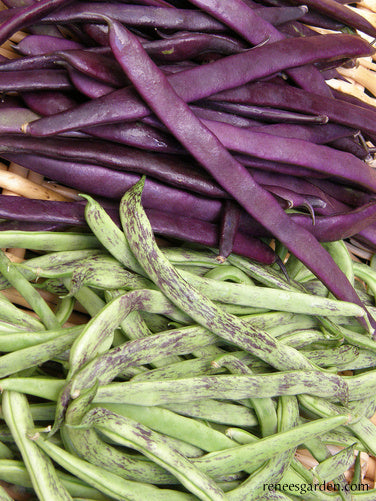

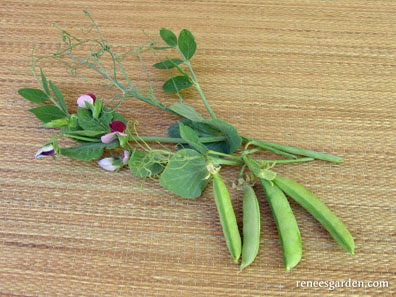

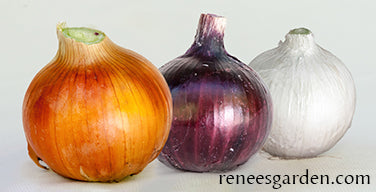

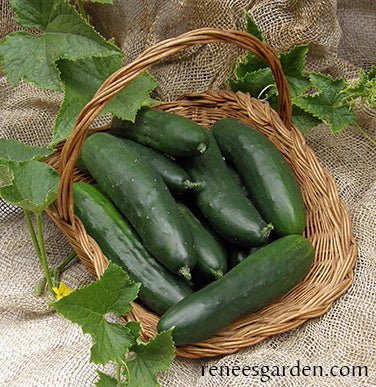

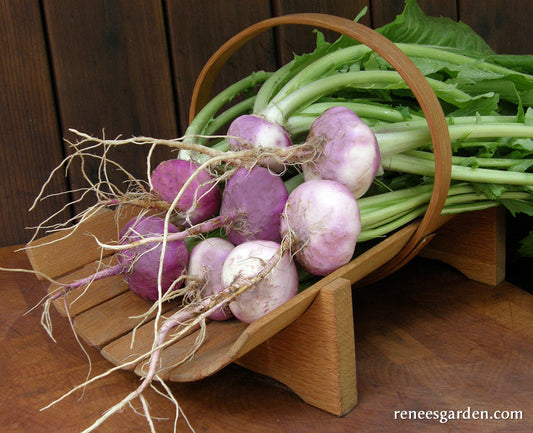

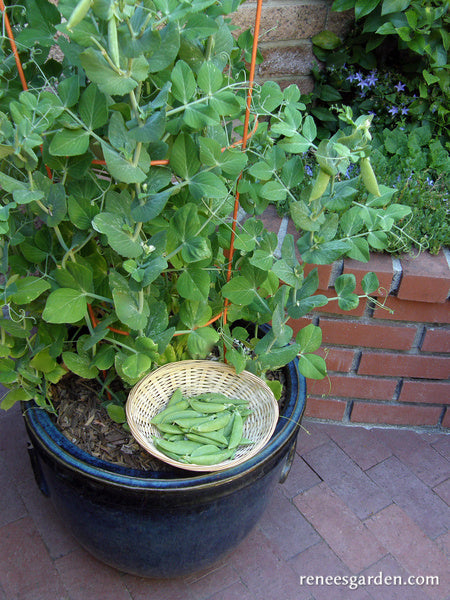

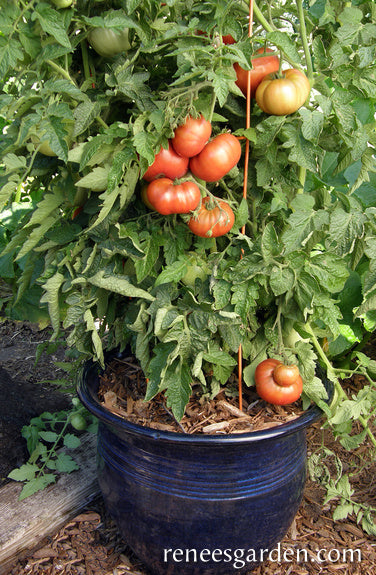

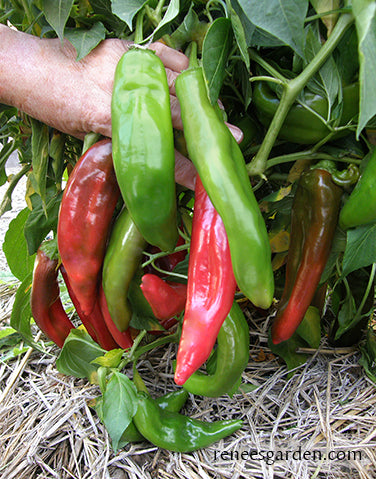

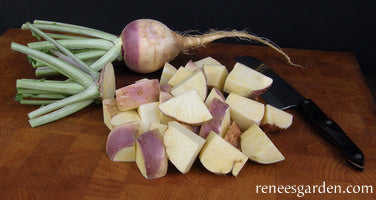

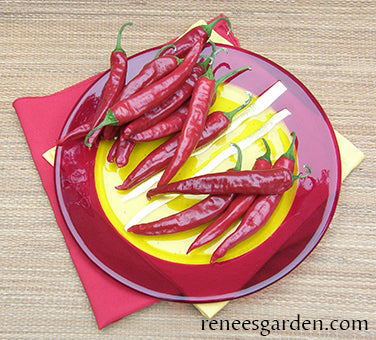



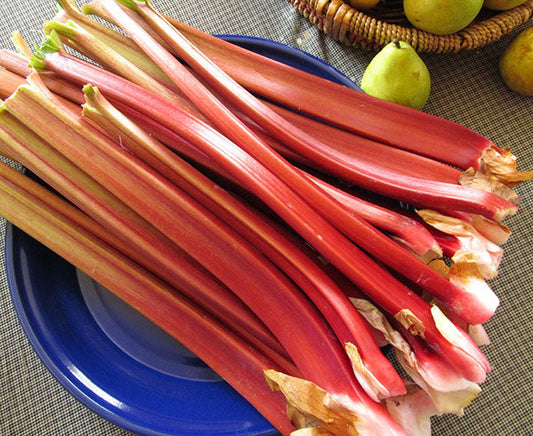
 See More About Our Rhubarb Roots
See More About Our Rhubarb Roots
